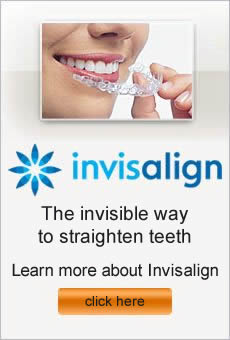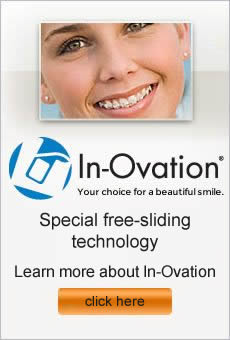Are you unhappy with your smile, but dread the thought of years in metal braces? If you suffer from a crooked or misaligned smile, but don’t relish the idea of orthodontics to correct your problem, SPEED braces may be an option to beautify your smile in a more appealing way.
Thanks to advances in orthodontic technology, treatment with SPEED braces often only lasts between three and nine months. There is no need for elastics or rubber bands. The appliances used for SPEED braces are more aesthetically appealing, as they are one-third smaller than the appliances used with traditional metal braces. This creates a sparkling appearance rather than the “metal mouth” or “railroad tracks” often associated with old style braces. Because they are smaller and more streamlined, SPEED braces are easy to brush and floss and do not cause irritation to the cheeks and gums.
SPEED braces utilize an innovative spring clip to straighten teeth by applying gentle and continuous force to move teeth into the desired position. You will visit your orthodontist approximately every two weeks for the few months you are undergoing treatment with SPEED braces.
SPEED braces are exceptionally comfortable, easy to maintain, and can provide you with a straighter, more beautiful smile in mere months. If you are unhappy with the look of your smile, talk to a qualified orthodontist about undergoing an evaluation to determine if SPEED braces would be suitable for you. With SPEED braces, you could be speeding along to a more perfect smile in no time!
Orthodontist for kids in Sherman Oaks CA
If your child’s permanent teeth are erupting, it may be time to think about taking a visit to an orthodontist. A dentist who is trained to specialize in straightening and aligning the teeth and bite is called an orthodontist. The ADA and the American Association of Orthodontists suggest children who are seeing the emergence of permanent teeth should be evaluated for orthodontic treatment. For most kids, this happens around the age of seven.
At this time, the orthodontist can detect potential issues with the incoming permanent teeth, as well as assess jaw growth. Having an evaluation does not mean your child will need braces, or that they will need them right away. Early screening simply helps the orthodontist recommend future treatment and develop a plan for addressing any problems they have identified. Issues such as overcrowded teeth or a misaligned bite are easier to correct while your child is still growing.
Historically, orthodontic treatment with braces involved a single-phase treatment that starts in early adolescence after all baby teeth are gone, and most of the permanent teeth have emerged. However, with current technology, many orthodontists now prefer a two-step process that can start much earlier. The first step usually uses an appliance to prepare the teeth and bite for the second stage of traditional braces. This two-phase treatment usually means a shorter time spent in braces than a one-phase treatment requires.
Having your child evaluated by an orthodontist early in their oral development will give you options for treatment that you may no longer have if your child is evaluated after all the permanent teeth are in place. To ensure your child a lifetime of spectacular smiles, get an evaluation early.
If you’ve just had braces applied, oral hygiene as you know it is about to change. You can’t keep on with your oral routines in the same fashion that you did prior to braces, or you’ll open yourself up to bacteria and gum disease, possibly even cavities. Along with regular checkups and cleanings, you’ll need to have good habits at home.
Braces need extra care. They’re bulky and they trap food in ways that will surprise you. Each time you brush, be prepared to see lots of food debris in your sink when you spit, and you can be certain that if you’re only brushing, you’re leaving behind even more food debris.
When you have braces, it’s recommended that you brush following every meal, not just twice a day. If you can’t brush, it’s essential that you rinse out your mouth and spit several times to clear out as much remaining food as possible. Brush gently around each bracket, first angled up along the gumline and bracket and then again along the top line of the bracket. Don’t just scrub, but be gentle and persistent, for a minimum of two minutes.
Flossing is a big challenge with braces. It takes more time and more effort. The floss must be threaded up, between each bracket and beneath the wire, threading it so that you can get the floss between each tooth. This must be repeated for each bracket in your entire mouth.
After flossing, you can use a rinse of half hydrogen peroxide and half water. Swish it in your mouth and allow it to penetrate the areas you’ve opened up with brushing and flossing. You’ll see the bubbles working! This can be a major help in maintaining gum health while wearing braces.
Talk to Sherman Oaks orthodontist Dr. Fotovat for extra tips on keeping your mouth fresh and clean while wearing braces so that when your braces come off, healthy white teeth are waiting for you.
If you are seeking treatment for crooked or misaligned teeth, one of the most appealing options available today is Invisalign. This innovative way to improve your smile utilizes a set of custom trays, called aligners, to correct and straighten teeth. Conventional treatment with metal braces can be uncomfortable, painful, unattractive and inconvenient. Treatment with Invisalign has many benefits when compared to other straightening methods, including:
Invisalign braces are hardly noticeable because the aligners are clear. If you would rather not sport the “metal mouth” look, Invisalign would be an excellent choice.
Invisalign braces are more comfortable than metal braces because the aligners can be removed when needed. Traditional braces are permanent until removed by your dental professional, but Invisalign trays can be taken out to eat or drink or for other brief periods of time as necessary.
Invisalign braces are safe and do not utilize wire and metal that can scratch and puncture the mouth or gums. The clear aligner trays are smooth, with no sharp edges.
Invisalign braces make cleaning your appliance and your teeth and gums a snap. Because the aligner trays are removable, they are easy to take and out clean, and then allow you to brush and floss your teeth normally.
Invisalign braces usually require shorter treatment time than traditional braces. Metal braces may take up to 5 years to complete treatment, but treatment with Invisalign generally takes 1 to 2 years.
The advantages of Invisalign are many, and lots of patients are excellent candidates for treatment with the clear aligners. If you are considering orthodontic treatment to correct your imperfect smile, consult with a dental professional to find out if Invisalign would be a good option for your specific needs. With Invisalign, you could quickly and easily be on your way to a more perfect smile.
Traditional braces have long been thought to be the only option available to straighten your teeth and correct your bite issues. Advances in Invisalign aligners now give you a choice, one that might just leave your mouth healthier when all is said and done.
Invisalign aligners are clear plastic trays that are worn for up to twenty-two hours a day. They can be removed while eating and for cleaning. A series of trays is prepared to slowly guide the teeth into proper position over time. When one tray has done its job, the next tray in the series is utilized.
Traditional metal braces are extremely challenging to clean. The brackets and bands trap bacteria and food debris all around the teeth, and in order to prevent gum disease and cavities, wearers must thread floss painstakingly under each wire and floss each tooth one-by-one, threading again and again. Brushing is challenging, too, as brushes wear out very quickly and can’t always reach the difficult areas. Even using a waterpick can’t be fool proof, because if used incorrectly, bacteria and debris are simply pushed further into the gum pocket, causing irritation and leading to infections.
Invisalign allows you to take out your trays so you can brush and floss normally, just as you did before you began your treatment. Trays are rinsed with water and placed back in the mouth. The teeth are clean and the aligner is clean, all in a fraction of the time it would take to clean a mouthful of traditional braces.
Keep your mouth healthier by talking to your orthodontist today to see if Invisalign aligners are right for you and your smile goals.
If your child just got braces, you will need to watch closely to ensure that all of the proper steps are being taken to ensure that when the braces come off, your child is left with a mouthful of healthy, straight teeth, not a mouthful of cavities and gum disease!
Oral hygiene is more complicated and involved with braces, and a child who already has good habits is going to be challenged to step up to the new routines. Brushing and flossing can be far more difficult with braces and can take twice as long – or longer! You may not have watched your child brush in years, but now is the time to start paying attention again.
Your child’s orthodontist explained the new routines to your child as part of the braces application, but after the “new” wears off, the excitement and the sense of urgency to brush and floss can dissipate, and bad habits can be developed. Your child’s first in-office cleaning could bring some surprises, as children who never had a dental problem might be faced with plaque buildup or infection in the gums. Some dentists recommend that children have cleanings every three months instead of every six while braces are in place because extra care is needed.
If your child isn’t caring properly for his or her teeth while wearing braces, you will need to be firm about good habits. Be certain that your child understands what could happen if bacteria takes hold. Formerly healthy teeth could need fillings or other repairs. Consider setting up a reward system for good or improved checkups. Pair brushing with a reward chart and stickers and give small treats for a week’s worth of good habits.
Some dentists have special, colored toothpastes available that enable your child to see exactly where plaque is hiding. These toothpastes leave green or blue behind until the brushing process is thorough and complete. Your child might think it is fun to have a green mouth and would find brushing much more interesting.
If you’re having trouble getting your child to brush and floss while wearing braces, talk to your child’s orthodontist in Sherman Oaks for more tips.



